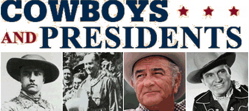Art review: Cowboys and Presidents
Nidia, 18, was surprised to see how often presidents have embraced the cowboy image over the years.

I never thought of presidents being influenced by a certain image. I was enthusiastic about going to the Museum of the American West at the Autry National Center in Griffith Park to see an exhibit on how the Hollywood version of cowboys has influenced presidents.
A lot of the displays in the exhibit Cowboys and Presidents portray presidents from President Theodore Roosevelt to this year’s presidential candidates, John McCain and Barack Obama relating to the cowboy image in posters, paintings, drawings and photographs. This was unusual because I think of presidents mostly as business-like and not as cowboys from the old West, who are seen in movies and on TV as brave, heroic, and strong; and also dangerous, violent and reckless. I never realized how American presidents have used the cowboy image so much until I saw this exhibit.
Even before the Hollywood cowboy image spread, Theodore Roosevelt, who was a real cowboy before he was elected president, made it popular. In 1898 a caricature (cartoon drawings with exaggerated features) titled Teddy the Terror shows Roosevelt as a cowboy, holding two pistols toward the sky. His upper body is the biggest part of the image and shows how in control and powerful he became as president. This image appealed to me because I put myself in the position of Americans during that time period. I imagined that they felt as he looked, strong and secure because he looks confident on his horse. Other presidents have tried to take on the image Roosevelt created to appeal to Americans, but sometimes the attempts backfired.
The caricature, Puppet, 1967 illustrates the cowboy image backfiring on President Lyndon Johnson because he is portrayed as the negative Hollywood version of a cowboy. He is shown jumping in the air, holding a gun, with an emphasis on his big rugged face. At the time Johnson wasn’t popular because of his war policy in Vietnam. Johnson’s image represents what people believed was unjustified violence and recklessness. It was interesting because I usually see pictures that make fun of presidents, not ones that depict them as threatening. Seeing that image made me think that Johnson was a violent president. Images like these were the most intriguing to me because they made me wonder why people and artists would portray the nation’s leader negatively and frightening.
I walked into the last room of the exhibit and saw giant photos of Democratic and Republican presidential candidates Barack Obama and John McCain. Obama is photographed tipping a cowboy hat that a volunteer gave him and McCain is shown signing a cowboy hat. The size of the photographs seems to exaggerate the candidates’ relation to the cowboy image. Neither candidate is going out of his way like former presidents Ronald Reagan or George W. Bush to tell Americans that they’re cowboys. No other art in the exhibit looked as candid as these pictures. They look like they are just going with the flow of things surrounded by everyday people. I think that the candidates accept that the cowboy image continues to be popular, but are not really embracing it. However, people can interpret these images as they like because both candidates are still establishing their characters.
I recommend this exhibit to people who like history and to people who keep up with politics. I had a lot of fun interpreting the art in the exhibit.
Cowboys and Presidents
Exhibit runs through Sept. 7.
Museum of the American West at the Autry National Center
4700 Western Heritage Way
Los Angeles, CA 90027
www.autrynationalcenter.org
Admission
$9 for adults
$5 for students (13-18) and seniors (60+)
$3 for children (3-12)
Free for children under 3
Hours
Tuesday through Sunday 10 a.m. to 5 p.m.
Thursdays open until 8 p.m.
Closed on Mondays









